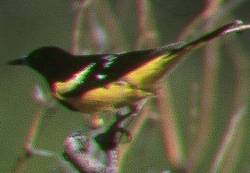- Scott's Oriole
Taxobox
name = Scott's Oriole
status = LC | status_system = IUCN3.1

regnum =Animal ia
phylum = Chordata
classis = Aves
ordo =Passeriformes
familia =Icterid ae
genus = "Icterus"
species = "I. parisorum"
binomial = "Icterus parisorum"
binomial_authority = Bonaparte, 1838The Scott's Oriole, "Icterus parisorum", is a medium-sized
icterid (the same family as manyblackbird s,meadowlark s,cowbird s,grackle s, and others, including theNew World oriole s).It is primarily found in the
Southwestern United States and south toBaja California Sur and centralMexico .This bird was named by
Darius N. Couch in honour of GeneralWinfield Scott . Although it was later discovered that it had previously been described by Bonaparte, the common name was retained.References
* Database entry includes justification for why this species is of least concern
External links
* [http://www.birdspix.com/ARCHIVE%20SPECIES%20PAGES/Scotts%20Oriole.html Scott's Oriole Photographs] - John S. Schwarz Bird Photography
* [http://vireo.acnatsci.org/search.html?Form=Search&SEARCHBY=Common&KEYWORDS=scott%27s+oriole&showwhat=images&AGE=All&SEX=All&ACT=All&Search=Search&VIEW=All&ORIENTATION=All&RESULTS=24 Scott's Oriole photo gallery] VIREOFurther reading
Book
* Flood, N. J. 2002. "Scott’s Oriole (Icterus parisorum)". In "The Birds of North America", No. 608 (A. Poole and F. Gill, eds.). The Birds of North America, Inc., Philadelphia, PA.
Thesis
* Randell SM. M.S. (1996). "A study of avian populations and behavior at a proposed wind energy production facility near Fort Davis, Texas". Sul Ross State University, United States -- Texas.
Articles
* Bell M. (2003). "From the field - August-November 2002". Oriole. vol 68, no 1-2. p. 19-31.
* Beohm RT & Beohm MF. (2002). "First record of Scott's Oriole from Georgia". Oriole. vol 67, no 3-4. p. 49-50.
* Calvert WH, Hedrick LE & Brower LP. (1979). "Mortality of the Monarch Butterfly Danaus-Plexippus Avian Predation at 5 over Wintering Sites in Mexico". Science. vol 204, no 4395. p. 847-851.
* Denis K. (1976). "Scotts Oriole near Thunder Bay Ontario". Canadian Field Naturalist. vol 90, no 4. p. 500-501.
* Flood NJ. (1989). "Coloration in New World Orioles 1. Tests of Predation-Related Hypotheses". Behavioral Ecology & Sociobiology. vol 25, no 1. p. 49-56.
* Hofmann CM, Cronin TW & Omland KE. (1680). "Using spectral data to reconstruct evolutionary changes in coloration: Carotenoid color evolution in new world orioles". Evolution. vol 60, no 8. p. 1680-1691.
* Kozma JM & Mathews NE. (1997). "Breeding bird communities and nest plant selection in Chihuahuan desert habitats in south-central New Mexico". Wilson Bulletin. vol 109, no 3. p. 424-436.
* Leck C. (1974). "Further Observations of Nectar Feeding by Orioles". Auk. vol 91, no 1. p. 162-163.
* Martinez Del Rio C & Eguiarte LE. (1987). "Bird Visitation to Agave-Salmiana Comparisons among Hummingbirds and Perching Birds". Condor. vol 89, no 2. p. 357-363.
* Newfield NL. (1984). "3 Records of Calliope Hummingbird Stellula-Calliope from Louisiana USA". Condor. vol 86, no 3. p. 346-348.
* Ornelas JF, Ordano M, Hernandez A, Lopez JC, Mendoza L & Perroni Y. (2002). "Nectar oasis produced by Agave marmorata Roezl. (Agavaceae) lead to spatial and temporal segregation among nectarivores in the Tehuacan Valley, Mexico". Journal of Arid Environments. vol 52, no 1. p. 37-51.
* Reddall J. (1977). "Colorado USA Field Ornithologists Official Records Committee Report 1972 through 1975". Western Birds. vol 7, no 3.
* Remsen JVJ & Cooper JR. (1977). "1st Record of Scotts Oriole from Colorado USA". Western Birds. vol 8, no 4. p. 157-158.
* Sundquist K. (1975). "Scotts Oriole Banded in Duluth". Loon. vol 47, no 1. p. 22-24.
Wikimedia Foundation. 2010.
